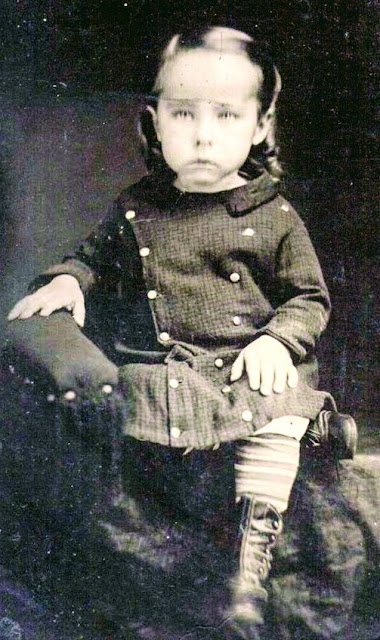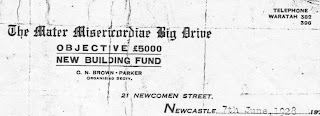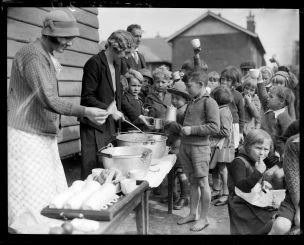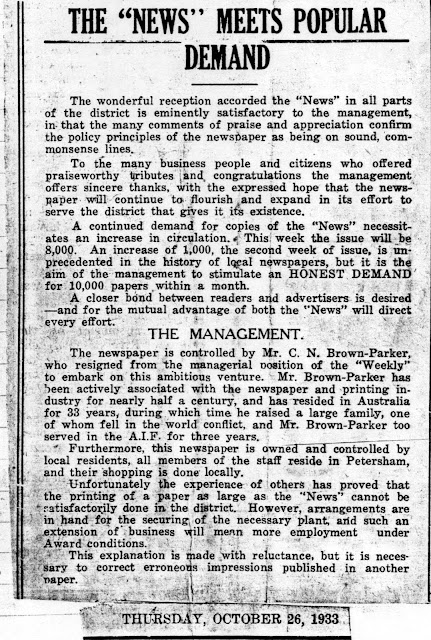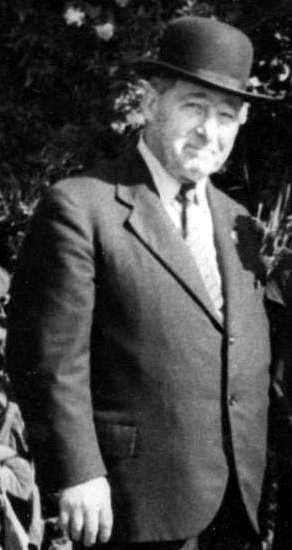GRANDFATHER’S LAST HURRAH
1874 – 1944
From Bertie Everett Brown to Charles Nelson Brown Parker: From Peru, Indiana to Sydney, Australia... it has indeed been a very long journey.
oOo
HIS STORY SO FAR- (FROM PREVIOUS CHAPTERS*)
Grandfather was born in the decade following the American Civil War, when his own grandfather, his father’s father Dennis Brown fought for the north. A soldier with a Quaker background.
Back in 1645 the family’s first Quaker, his many times over great-great grandfather Richard Browne, would not have approved.
Bertie’s maternal grandmother Charlotte De Moss, Laura Brown’s mother was born into a prominent southern family whose roots went back to France. They too had fled the old country seeking freedom from repression.
And in between, in the centuries of Brownes and Browns, Mercer’s, De Mosses and Welch, when Grandfather could and should have laid claim to countless generations of American pioneers, he did not. Strange to think he never once mentioned these praise worthy ancestors in any of the many brag sessions he held with interviewing journalists.
Perhaps he knew nothing about them.
What happened in the nineteen years between Grandfather’s birth in 1874 and the last recorded sight of him as Bertie Brown in Indiana in 1893 we really haven’t a clue. I know only that he was born the eldest child, his only surviving sibling was his sister Leota, his parents were John Brown and Laura Welch.
It’s impossible to guess why but eventually there came the day his parents broke up, his father spent time in a penitentiary, and suddenly Grandfather is no longer living in Indiana: He left home as Bertie Brown, never to return, and for ever more was known as Charles Nelson Brown-Parker.
oOo
THE SISTER WHO KEPT IN TOUCH
 | ||
| Leota Brown, Chas-Bertie’s sister in Indiana, USA about 1925. |
His sister never married and following their parents separation she and her mother Laura worked as dressmakers. Leota alone kept in touch with her brother after he left the family home and obviously was privy to his new identity.
Charles and Maggie named their first born Leota; some years later Bill and May Brown Parker would name their first daughter Leota.
A postcard from 1923 has survived the years and proves that by then at least Grandmother Maggie knew her husbands true identity.
oOo
RUNNING OUT OF TOWNS
June 1927. I guess home is the only place to head to when life is tough; or in the absence of a permanent abode, family will do: Maggie, Chas and the girls have moved from the upset and humiliation of Bundaberg to Newcastle, where Bill and May have settled with their daughters Leota and Gloria. A son Barry has yet to arrive.
In the same general area around Newcastle, Bert has begun courting his bride to be Mary Sophia Merchant, while Bob is set to tie the knot with Molly in nearby Stockton. In years to come Bert and Mary will return to live permanently in Newcastle, taking an active and keen interest in community affairs and raising their four children.
One, Rosemary, will become a pharmacist, and their son John will be a journalist. Margaret and I will be of the same vintage, while the youngest, Barbara, will luckily prove to be a bower bird, maintaining her late father’s stewardship of Chas Brown Parker’s old and dusty memories.
Without these keepsakes Grandfather’s story might never have emerged.
oOo
THERE’S ALWAYS FUNDRAISING...
Once he arrived in Newcastle Chas had no trouble finding a position with Newcastle’s Mater Misericordiae Big Drive fund raising Committee. Like all Mater Hospitals dotted around Australia at the time, the Catholic Church oversaw the fund-raising on behalf of the Sisters of Mercy.
Grandfather spent a successful ten months organising carnivals and raffles; I know this because when he left he received a curiously worded letter of commendation from the Committee.
The letters sentiment’s appeared sincere; it was the heavy emphasis on Chas’s honesty that made me wonder if his mangled and tainted past had continued to dog him, not only in the far north of the continent, but way south past Bundaberg and Brisbane and was still bugging him here in Newcastle.
I don’t think there has ever been a reference so comprehensively endorsed as this one appeared to be by the Police Department and the Attorney General. It’s a wonder Chas didn’t have it framed.
However one niggling little doubt kept lurking around in the back of my mind; the letter is typed, not on a Committee letter head, but instead on stationary embossed C.N.Brown Parker, Organising Secretary.
I don’t doubt the President of the committee signed the letter, but I do wonder who actually created its effusive content. Could this be yet another of Grandfathers ‘do it yourself’ jobs.
I’ve copied the letter-head, but the body of the letter has been photocopied so many times it is almost illegible.
Whoever wrote the letter covered every possible base; with a letter like this no one could possibly point an accusing finger at Chas.
TO WHOM IT MAY CONCERN
I have pleasure in stating that Mr. C.N.Brown-Parker was engaged as Organiser for various functions on account of the Mater Misericordiae Hospital, from June 1927 to March 1928, during the whole of which period he worked most industriously and enthusiastically displaying interest and energy on a most commendable scale.
The books in connection with the several undertakings were kept in a manner satisfactory to the Auditors, the Police Department and the Attorney-General. During the operations referred to Mr Parker handled large sums of money and the members of this Committee have placed on record their appreciation of his honesty and the methods he adopted to prevent leakages in every direction.
I shall be pleased at all times to give a personal interview to any prospective employer and have no hesitation in recommending Mr Parker to any position to which he may aspire.
Signed M.I. Moroney. President
oOo
FAMILY ALBUM - NEWCASTLE
 |
Rewa and her small cousins Newcastle
|
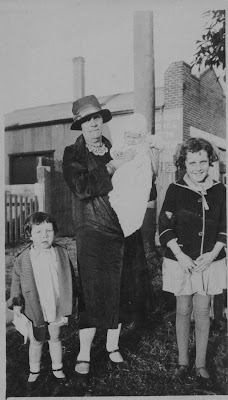 |
Maggie, Rewa with Bill’s girls Leota and baby Gloria
|
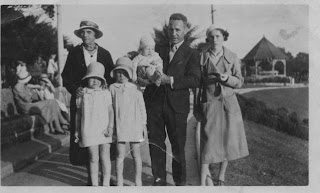 |
| Bill’s family with Rewa & Maggie |
DEATH OF GERALDINE, MAGGIE’S MOTHER
If you delve back through the Ancestor series to Four Sisters from Sussex*, the story that lead into Maggie’s marriage in Fiji, you will meet her mother Geraldine Sweeny.
Geraldine faced innumerable challenges in her life, a childhood of family shame, two husbands, two voyages under sail across the world. Like her three sisters who all came to Australia she proved to be a woman of strength and character. I might not have mentioned the fact, but back in the United Kingdom, the four girls had left behind three other sisters, Alice Kate the eldest, Madeline May and the youngest Constance Olivia whose life would be short and tragic.
In a future story you will meet Constance Olivia’s son, Frank Fleming, my Grandmother’s cousin; he together with Noel Coward and Amelia Earhart, will bring great comfort to my life and not a few grateful tears, but not until Frank himself has been dead for over forty years.
At the moment though, it is 1931 and Geraldine has died in Sydney at the age of 82. She alone survived her three Australia domiciled sisters Adeline, Camilla and Bertha. We have a few photographs of her and they show a surprisingly tall lady, much taller than her diminutive Fiji born daughters.
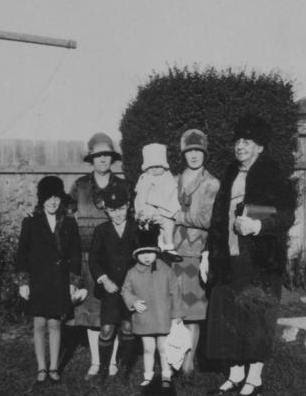 |
Geraldine, not long before her death
|
In the photos her impression never wavers from stern boredom, or perhaps disapproval. Maybe she too, like Maggie’s brothers had not welcomed her daughter Maggie’s marriage to the young American with the silvery tongue.
Maybe she has been observing from afar her son-in-law’s constant misdemeanours and is not amused.
While her McGowan and Foreman sons, and one Foreman daughter remained in Fiji, Geraldine and three of her younger daughters from her second marriage to Robert Foreman spent the remainder of their lives in Sydney. Geraldine was the last of the Sweeny sisters.
So at least my Grandmother did have kin nearby.
oOo
1930-1939 DEPRESSION YEARS
SOUP KITCHENS & CHARITY
The Wall Street Crash of 1929 quickly reverberated around the world; by 1930 Australia was firmly in the grip of Depression. Almost overnight the market had crashed, jobs were lost, families torn apart as husbands and fathers took to the road to find work.
Soup kitchens and shanty towns for the homeless began to spring up throughout New South Wales. Government handouts were barely enough to keep a family alive.
No doubt Grandfather lost his job with the fund raising committee because of the financial crisis. With no work to be found in Newcastle ChasBert moved Maggie and the girls to Sydney. By then Bill and Bob were married and they and their wives gravitated between Newcastle and Sydney.
There is a story that Bill won some money in a lottery and at his wife May’s urging bought a modest little cottage in Merewether, a suburb of Newcastle. Of course she was thrilled, up to then they had lived in rented flats and rooms. But the joy was short lived. Uncle Bill loved the gee gee’s, horse racing to the uninitiated, and it wasn’t along before the house had to be sold.
oOo
Today’s generation probably find it difficult to imagine the harsh reality of life during a depression without money, roof, self esteem or opportunity; or for that matter the inordinate length of time their parents or grandparents had to exist in this abject poverty. Forget credit cards, forget generous unemployment benefits, think eviction, think grinding poverty.
A few family stories have emerged from those years. The job Bill managed to find in a biscuit factory where he brought home the broken produce in a suitcase for Maggie and the girls to hawk around the neighbourhood.
Or when Viti found work in the country bringing home at weekends a case of bruised oranges for Maggie and daughter in law Molly to make into jam; again to be sold to neighbours for the odd penny or so a bottle.
Or for that matter the time the landlady who owned the rooms they were living in found Grandmother cooking on a small primus stove and turned them out into the street.
oOo
I can imagine my Grandfather at this time, desperately trying to turn a trick, searching for scams and schemes to bring in money, anything to keep the wolf from the door, the family fed.
But he’s getting on in years now, too old for the boxing circuit, no longer the dandy of the stage. Fund raising and carnivals are out of the question, no one has spare cash to give to charity or spend on frivolity.
But he does find a solution of sorts.
oOo
 |
Early days Parramatta Rd parade – pix by JG Park
|
THE LEICHARDT WEEKLY
Again Grandfather returns to his original trade. He and Maggie have moved to the Sydney suburb of Petersham, midway between Sydney’s centre and Parramatta, where Chas takes up a position with the Leichardt Weekly.
The paper is run by a Mr G.R. Brickhill, but within a year this gentleman issues a statement that after one year in the job...
‘...circumstances have now arisen which makes reorganisation desirable. The newspaper has been placed in full control of Mr. C.N.Brown Parker...’
Three months later, in October 1933, a news story appears that seems to herald the papers change of name with the heading...
THE NEWS MEETS POPULAR DEMAND
The story is in effect extolling the increased circulation of the paper and advising that the Management is now controlled by Mr C.N. Brown-Parker who resigned from the Managerial position of the Weekly.
Grandfather goes on to give a potted version of his experience in the news print industry, thirty three years resident in Australia, his large family, a son who fell in the world conflict (incorrect, but this after all is ChasBert’s version), and his own service in the Australian Infantry Forces in World War One.
These were some of the worst years of the depression. Shop owners were abandoning premises, money was tight and it is hard to understand how Grandfather could suddenly become the manager of a newspaper, even a small free one that I suspect the ‘News’ was. Papers like these relied solely on advertising.
The explanation probably lies in the statement where he says the paper is owned and controlled by local residents, and in the earlier one where it’s original manager spoke of ‘circumstances arising’.
In other words the paper has gone bust, and Chas, never one to pass up a good opportunity, has seen a chance to resurrect the business by convincing local businessman to contribute running costs in return for cheap advertising.
He puts the entire family to work. Bert, Mary and Viti, and later both Bob and Bill. There are advertisements to create, customers to canvass, payments to be collected and papers to be distributed. For a while Chas keeps the paper afloat and the baying wolves from the door.
These weren’t the best of times to run a business. The depression was deepening and news from other parts of the world relayed doom and gloom. Germany was moving more and more under the influence of Adolf Hitler and the Nazi party. Many Aussies may not have been aware that war, once again, was just around the corner.
How long did the paper last? I suspect not all that long.
oOo
FAMILY ALBUM
 |
| Selection of Rewa’s hats – Sydney war years |
AUSTRALIA GOES TO WAR
 |
HMS Formidable berthed Circular Quay Sydney 1945 – State Records NSW
|
The year is 1937, Viti has been working on a paper in the country town of Inverell but makes frequent trips home to see her mother.
Rewa has become a milliner and her work can be seen in the many family photos of the time. The Brown Parkers have moved from Petersham to nearby Hurstville, and Rewa falls in love with Guy the boy next door.
The following years brings a mixed bag of joy and despair. England declares it is at war with Germany and the Brown Parker boys don the uniforms of the Australian Armed Services.
From my parents point of view their news is good, their daughter Robyn is born and her first five years of life will be spent entertaining and being entertained by her maternal Grandfather, Charles Nelson Brown-Parker. Theirs will be a mutual admiration society, a short but close relationship that will leave a lasting imprint on his grand daughter’s memory.
Charles doesn’t know it but these will prove to be the last few years of his life. He will live through most of the war years, watch his sons and grand daughter Leota join the armed forces. He will see Bob sail off to the Middle East but miss his safe return.
Through news reports he will follow the war and ponder the fate of a world in turmoil. He will hear the broadcasts of Japanese invasion in Hawaii and will see the bombing of Sydney by Japanese midget subs. He will ensure the women and children of his family are evacuated to the country town of Inverell until the immediate danger is over. He will bring home lonely American servicemen to eat at his table.
And throughout these last years and months of his life Maggie will be by his side as she has been for the past forty four years.
Charles Nelson Brown Parker, also known as Bertie Everett Brown will be buried in Sydney in February of 1944 in the presence of Maggie and his children’s families, and mourned by a small grand daughter who will forever remember him with love and affection.
oOo
NOT UNDERSTOOD
In writing Grandfather’s story I’ve stuck to the truth, warts and all. He left behind only a few clues, the rest we had to search for. I’m sure he hadn’t foreseen the age of digital wizardry when his past would be laid open for all to see, might even have hoped we would never see the entire picture.
He was a wily character and a great survivor. Though to be honest he had only himself to blame for a great deal of the trouble he ultimately found himself in. I’m sure he truly believed he was merely defending his principles and the honour of others when his temper got the better of him.
Among those keepsakes my cousin Barbara found, mixed in with all the newspaper cuttings and old work place references he kept another surprising item. A seven stanza poem entitled ‘Not Understood’. I’ve no doubt he could recite the words by heart and felt they were written especially for him.
The poem was written by an Irish settler in New Zealand, Thomas Bracken before he died in 1898. It could almost be my Grandfather’s made to order epitaph.
THE END
oOo
*Four Sisters from Sussex
*Ancestors Series Fiji NZ Australia
*Ancestors Series Fiji NZ Australia
Next – MAGGIE’S RETURN TO FIJI
Future chapters - From Sussex a WW1 Pilot
- Fiji Maggie’s legacy
Robyn Mortimer©2011
